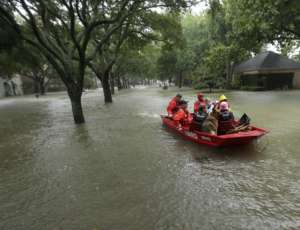

The Homeland Security Department isn't the only agency working on rescue and response to Hurricane Harvey. Other agencies are doing their part to help impacted...
American astronaut Peggy Whitson ends her streak for most cumulative time in space in five days, and NASA is doing everything it can to keep a tropical storm from postponing her homecoming.
As of Monday evening, NASA not only planned on Whitson’s scheduled Sept. 2 landing in Kazakhstan, but also expected to host her final news conference Aug. 30 from the International Space Station, despite the Johnson Space Center’s (JSC) closure for Hurricane Harvey.
According to JSC, the center is closed Aug. 29 to everyone but mission essential personnel. The center also was closed Aug. 28 to everyone but mission essential personnel.
NASA spokeswoman Kelly Humphries told Federal News Radio in an email that the JSC Recovery Team is made up of about 125 people staying on the center’s grounds. This team includes the International Space Station Mission Control, and James Webb Space Telescope support teams.
“Some team members stayed at JSC overnight,” Humphries said. “The center provided cots as well as Meals Ready to Eat (MREs). Employees were made aware before they came on shift that they might need to remain, so they came prepared as well.”
The JSC emergency management team said senior managers are evaluating the center’s status on a day-to-day basis, and instructions on excused leave will be issued after the center reopens.
“Due to school closures and the likelihood of flooding and power outages across the JSC and surrounding Houston area, it is unreasonable to expect employees to telework safely,” the team said in its statement.
“JSC may see 20-to-30 mph winds on Tuesday and early Wednesday with gusts to 40 mph,” the center’s emergency management team said. “Occasional periods of moderate to heavy rain are still likely through Wednesday afternoon. The bull’s eye for heaviest rainfall may be shifting a bit inland from JSC today. It is possible we’ll get 3-to-5 inches of additional rain today and 5-to-7 inches tomorrow. The rainfall total at Building 30 as of noon today is 31.66 inches.”
Building 30 is home to the mission control center. Employees are urged to carry supplies with them in case they’re stuck on site at the center. Facilities managers are instructed to stay away from the center until they hear from their recovery teams.
The directions from NASA are similar to those communicated by other federal agencies with Houston-area outposts.
LeAnn Jenkins, acting executive director of the Houston Federal Executive Board, said her job right now is providing information to agency heads so they can decide on operating statuses for their respective workforces.
“Our federal executive board does not make recommendations on closures,” Jenkins said during a phone interview from her office in Oklahoma City. “It’s really the agency heads who are responsible, so we provide them with the information they need to make decisions.”

That information includes weather forecasts, airport closures, federal office closures — which are then communicated to the Office of Personnel Management — updates from FEMA and the Army Corps of Engineers, and even phone numbers to call for abandoned vehicles.
“We’re letting employees know there’s websites to go to to see if their car’s been impounded, or if your car isn’t where you left it, what do you do,” Jenkins said. “We’re letting them know what shelters are open in that area, if they had to relocate from home and don’t have family in that area.”
The Houston FEB oversees roughly 31,000 federal employees and 107 in the upper Texas Gulf Coast region, according to the site.
Jenkins also has sent out information on shelters for pets, steps to protect against looters, and also how to get in touch with rescue workers.
“One of the unexpected things is the impact of social media,” Jenkins said. “People are so tuned into posting on Facebook or tweeting, they may be posting from the second floor of their home because the first floor is flooded. But rescue workers aren’t going to get that. They need to call 9-1-1 or one of the telephone numbers that rings into the Coast Guard command center.”
Jenkins said agency personnel wondering about their office’s operating status should take steps like they would during any other weather event: look for updates through official agency communication channels.
The Houston Veterans Affairs Medical Center, for example, has been posting information about its operating status on its website. As of Monday afternoon, the center is open. With the exception of the Lufkin location, all VA outpatient clinics in the area are closed Monday and Tuesday.
“The Houston VA Medical Center is open and functioning with sufficient staff to manage patient care,” a statement on the center’s website says. “Because of flooding, patient and staff safety is the utmost priority. If you have medical needs and can make it safely to the medical center, please be careful. If you do not have urgent medical needs, please stay in a safe location and heed the guidance of local government officials. We will contact you to reschedule your appointments once the weather conditions improve.”
Veterans can also call the Telecare Call Center at 1-800-639-5137 or use MyHealtheVet Secure Messaging to contact VA with medical issues or questions. The department is encouraging veterans to check the Houston VA website and Facebook and Twitter pages for updates.
As the rain continued and flood waters rose, OPM reminded agencies of the variety of emergency authorities it can use to help impacted federal employees.
For example, the Emergency Leave Transfer Program, where federal employees can donate unused annual leave to other employees in the same agency or other agencies who might be directly impacted by the storm or have family members who are adversely affected, may be an option.
Agencies who have employees who need help should contact their headquarters to get the process started. OPM will work with the Office of Management and Budget and agencies to set up any emergency leave programs.
OPM is also reminding agencies of the existing emergency critical hiring and direct hire authorities they can use to bring on additional support as FEMA and other agencies continue search and rescue operations and later begin recovery work. Agencies can, for example, make 30-day appointments to fill needed positions. They can also re-hire retirees under special circumstances to fill critical mission gaps.
The Homeland Security Department’s U.S. Computer Emergency Readiness Team also is warning internet users to be cautious of phishing scams asking for donations in the aftermath of Hurricane Harvey. Emails may contain subject lines, links or attachments related to the storm that appear to be from a creditable source.
“Emails requesting donations from duplicitous charitable organizations commonly appear after major natural disasters,” U.S. CERT said in an Aug. 28 alert.
In addition, OPM may grant permission for agencies to conduct special solicitations to support victims of Hurricane Harvey.
Meanwhile, the Federal Employee Education and Assistance Fund will begin asking its constituents for donations to help support federal employees impacted by the storm.
Disaster relief is one of several areas where FEEA typically provides support, though its ability to give grants and loans depends on available funding.

“We don’t have deep reserves right now, so a disaster like this requires us to ask for help in order to then be able to provide it,” FEEA Deputy Director Robyn Kehoe said in an email. “Donations always go where they are most needed, which right now is to victims of Hurricane Harvey.”
Impacted federal and postal employees employed with an agency and impacted by presidentially declared disasters can apply for a maximum FEEA grant of $500 to find temporary housing or make home repairs not covered by insurance.
Harvey victims can find more information about FEEA’s grants and loans here. Anyone can find more about information about making a donation here.
The National Treasury Employees Union announced it will match every dollar donated to FEEA’s disaster relief fund up to $30,000.
The federal government’s preparation for Hurricane Harvey started over the last week with DHS pre-positioning people and supplies throughout the southwest.
The state of Texas mobilized a large number of National Guard troops and DHS initiated its surge capacity, said Brock Long, the administrator of the Federal Emergency Management Agency during a press briefing on Aug. 28.
DHS acting Secretary Elaine Duke initiated the surge force by designating employees who are tasked and deployed to respond to the hurricane. Among those in the force are 1,300 FEMA employees to help with claims under the National Flood Insurance Program.
FEMA is coordinating the entire federal response to the hurricane, but as Long and others said, recovery is not at the forefront of the federal effort quite yet. The National Weather Service predicts another 15-to-25 inches of rain to fall over the next few days.
Long said the Army Corps of Engineers is working to restore power and providing emergency generators to support critical infrastructure like 911 centers. He said DHS is providing emergency communications to help Texas re-route 911 centers and making sure we are interoperable between federal, state and local first responders.
At the same time, the Coast Guard has deployed 27 fast response rescue teams to help citizens who are trapped.

“We have thrown every Coast Guard asset available at this response,” said Adm. Paul Zukunft, commandant of the Coast Guard. “The good news is thousands of lives are being saved and that is our objective right now. We are not out of this by a long shot so we are also posturing this to sustain this effort as well.”
Zukunft said upon request from the state, the Coast Guard will bring in more resources.
He said the Custom and Border Protection and Air National Guard are bringing in resources. The Air Maritime Operations Center, operated by CBP, is handling the air space deconfliction.
“We are flying at very low altitudes to effect rescues,” he said. “We are monitoring every media source available, what’s coming into the call centers, the Twitter feeds and we are looking at Google maps to see where those Twitter feeds are coming from so if there is a concentration of calls so we can be a little more proactive to determine where we are.”
Additionally, the Coast Guard has 11 aircraft looking for oil spills. Zukunft said they haven’t found any, but they are monitoring activity.
Long said victims of the flood should call their insurance agent to begin the process of recovery. Now that President Donald Trump approved the disaster declarations for Texas on Aug. 25 and one for Louisiana on Aug. 28.
He said more than 450,000 disaster victims are expected to be filing claims under the flood insurance program.
“That is a huge number but we are ready to go to process. We’ve already processed over 15,000 calls over the last 24 hours and getting citizens registered for disaster assistance. We will start processing and setting up your case management to go forward there,” he said.
One big concern is whether FEMA’s flood insurance program has enough money to help Texas and Louisiana citizens before it’s authorization expires on Sept. 30.
“We do have the reserves in the funding to be able to address this flood as well,” Long said. “There is a lot Congress can do. They can reauthorize the NFIP program in a multi-year authorization. They have a real opportunity rebuild the business framework as well as how we fund the insurance going forward in flood plains.”
Copyright © 2024 Federal News Network. All rights reserved. This website is not intended for users located within the European Economic Area.
Jason Miller is executive editor of Federal News Network and directs news coverage on the people, policy and programs of the federal government.
Follow @jmillerWFED
Nicole Ogrysko is a reporter for Federal News Network focusing on the federal workforce and federal pay and benefits.
Follow @nogryskoWFED
